Introducing the latest myCWT product and service enhancements
Building on our digital, omnichannel myCWT platform, our new products and services will simplify travel management for you and your employees – anytime, anywhere, anyhow.
Note: Featured services may not be available in your country at this time. Please reach out to your CWT representative for more details.
Hear from Chief Product Officer, Erica Antony as she shares the key product highlights of 2024, along with the key areas driving innovation.
-

2040: Baseline, Boom or Bust
As we enter an era of rapid transformation and unprecedented challenges, it is essential for travel managers, meeting & event planners, and corporate decision-makers to look ahead and frame our current strategic thinking with a clear vision of the future. Business travel and meetings and events (M&E) are poised for significant change over the next decade and a half, driven by a complex interplay of sustainability goals, technological advancements, evolving work models, and geopolitical dynamics.
In this paper to mark the 10th anniversary of our Global Business Travel Forecast, we explore, for the first time, a long-term vision of the future and potential trajectories through three distinct scenarios, each offering insights into how these forces should affect policy-making, budgeting and priorities. By examining these scenarios, we can better understand the diverse possibilities that lie ahead and the strategic imperatives required to thrive in each potential future.
Based on trajectory data analysis and interviews with industry leaders, behaviorists and climate tech founders, this forward-looking approach enables us to anticipate changes, strengthen our strategies, and make informed decisions that align long-term objectives. It is through this lens of foresight and adaptability that we can build resilience, seize opportunities, and navigate the complexities of the future.
We invite you to reflect on the insights presented, and consider how your organization can prepare for the opportunities and challenges that lie ahead. Together we can ensure that travel and meetings remain catalysts for growth, scalability and sustainable practices.
- Scenario development is both an art and a science
- Megatrends Shaping the Future of Business Travel, Meetings and Events
- Sustainability goals the new crux of corporate policy
- Technology Revolutionizes Travel Management
- Modern work models spark new travel patterns
- Changing demographics open doors to new opportunities
- Three Scenarios: Base case, boom and bust
- Future-proofing strategies

-

CWT GBTA Global business travel forecast 2025
When it comes to pricing, global business travel has finally reached an enduring, higher baseline. Prices will continue to rise in 2025, but only moderately, so expect a period of normalized growth.
However, this pricing environment, one of marginal gains and price regularity, is fragile. Global leisure travel has now realized a lot of its pent-up demand, while corporate travel has been resurgent, with 2024 edging at preCovid levels.
There are many factors at play, whether its volatile oil prices, labor costs and constraints, inflationary pressures, and geopolitical factors. As this elevated baseline edges upwards, albeit marginally, travel budgets will come under increased scrutiny, especially as travel patterns and attitudes change.
It’s why business travel can’t be viewed in a silo, and the true value to an organization must be fully realized. This forecast can help with those calculations.

-

Capitalize on emerging technologies in corporate travel
Technological advancements are accelerating at an unprecedented pace. How will emerging innovations like Generative AI, blockchain, and self-sovereign identity (SSI) transform corporate travel?
BTN and CWT probed global CEOs, travel managers, industry consultants and tech experts on the promises, questions, and expectations these innovations raise and how they are set to reshape traveler experience, cost control and service delivery in corporate travel and events.
Download and discover
- The technologies that will have the greatest impact on corporate travel in the next 2-5 years
- How these emerging technologies are poised to control costs, enhance service and security, and boost efficiency
- The critical challenges, opportunities, risks and roadblocks each innovation raises
- What travel managers, buyers and experts anticipate from these innovations

-

CWT Meetings & Events says sustainability Is key for events in 2020
CWT Meetings & Events, the global meetings and events division of CWT, says that sustainability will continue to be an ever more important business consideration for the $840 billion industry in 2020, according to the M&E 2020 Future Trends Report bonus feature, The Future of Sustainable Events, published today.
As activists protest in some of the world’s best-known destinations – including London, Sydney, Amsterdam, Madrid, New York and Washington, DC – demanding action on climate change, companies are increasingly taking notice.
“The sustainability of the meetings and events industry, in fact of the entire travel industry, is at the forefront of companies’ and planners’ minds in 2020,” said Derek Sharp, Senior Vice President and Managing Director, CWT Meetings & Events. “It’s driven by news coverage of climate change but, more importantly, it’s supported by the next generation of travelers – the millennials who are poised to become the biggest group of business travelers globally from 2024 onwards, and the centennials who are right behind them.
“These are people for whom travel has become commonplace and accessible in a way that it wasn’t for older generations,” Sharp added. “They want to continue meeting in popular destinations, but they are also hyper aware of the need to adopt sustainable practices that respect the environment and local communities wherever they go.”
Deloitte’s Global Millennial Survey 2019 has found that climate change is the greatest concern for this generation.
In response, companies and meeting planners are adopting various initiatives, including offsetting air miles with carbon, eliminating plastic waste, opting for locally-sourced and produced food and drinks, or choosing ethical suppliers.
As consumers and employees around the world seek out companies and brands that reflect their values, major international initiatives such as the United Nations Sustainable Development Goals are helping to drive home the message that, in 2020 and beyond, sustainability and responsible business are no longer just a feel-good item on HR’s agenda, but have real consequences for a company’s brand and bottom line.

CWT is a leading global partner in business travel, meetings, and events. Operating across six continents, we deliver sustainable, tailored solutions that help organizations connect, engage, and thrive in an evolving world. Our myCWT platform integrates advanced technology with human expertise to simplify travel and enhance traveler and attendee experiences. Extensive global coverage, seamless data integration, AI-driven analytics, and carbon-conscious travel tools enable businesses to optimize their travel and meetings programs while delivering measurable value.
With 150 years of industry experience and a deep commitment to partnership, CWT collaborates with clients to shape the future of business travel and events, making them more efficient, responsible, and impactful.
CWT Meetings & Events
CWT Meetings & Events (M&E) is an award-winning global corporate events management service. Representing all industry sectors, CWT M&E delivers comprehensive live, virtual and hybrid event solutions for thousands of customers every year. Ranging from end to end productions of some of the world’s largest and complex global conferences, through to intimate national teambuilding experiences.
Follow us on LinkedIn, Facebook and Twitter. -

Traveler Tribes
Get an understanding of what your travelers’ want
The key words to succeed in addressing travelers individually are “traveler segmentation”. This approach gives you a better understanding about the different types within your business.
Traveler profiling allows you to specify your employee messages and maximize your travel program. There are different breeds of business travelers that are starting to shift lines from what we would have traditionally expected. Technology, millennial global trotters and evolving expectations means it’s time to decode what these new tribes might look like.
Business Traveler Tribes

Why profiling can help your program
The key words to succeed in addressing travelers individually are “traveler segmentation”. This approach helps to profile travelers and gives you a better understanding about the different types within your business.
So why do so many organizations squeeze their employees into a one-size-fits-all box and wonder why their policy is ignored and their program compromised?

All your travelers are different
Traveler profiling allows you to specify your employee messages and maximize your travel program.
There are different breeds of business travelers that are starting to shift lines from what we would have traditionally expected. Technology, millennial global trotters and evolving expectations means it’s time to decode what these new tribes might look like.
Why understanding each individual traveler should be on your to do list
It’s safe to assume that each individual traveler in your organization has different needs, expectations and preferences when they travel for business. However, it’s also safe to assume the majority of programs segment their employees by the usual data sets – gender, age and job level… have you tried profiling employees based on a wide variety of data giving numerous profiles that are unique to your business?

Me, my data and I
At CWT we use three sets of data to give you a clearer picture of each individual traveler:
- Information from us the TMC
- Expense data
- HR data
This helps create profiles for different traveler types to give you a better understanding of what kind of travelers your company has.
Sneak preview of one of the tribes found in your ebook:
Collaborative FOMOs – The ultimate networking traveler
Characteristics: The Collaborative FOMOs (Fear Of Missing Out) can be found in middle-management. They are engaged, use travel for maximum collaboration and enjoy business trips. This tribe is using technology to the max and searches for all available resources to stay well informed. They value the human element over a commoditized and impersonal experience.
What is important to them: These travelers are not very picky when it comes to accommodations as long as they have a place to work and a great wifi connection. The collaborative FOMO tribe covers a whole spectrum of traveler types from those who want a travel manager or TMC on 24/7 speed-dial, to those who will quite happily turn to an app, a website or a virtual assistant to resolve an issue.

-

Don’t be like the rest of them, darling – Are we unique or do we share common traits?
Fashionistas might guess the author of the quote that gives title to this post. Coco Chanel was of the opinion that to be irreplaceable, one must always be different.
You might not agree with this statement, but what it is unquestionable is that – nowadays –developments in big data have made it possible for companies to customize their services to match clients’ preferences and cater for their differences. And travel is no exception.
We might not be unique but we certainly love to feel like it, that is why we adore when companies know who we are and what we want, and offer us exactly that.
Nobody has the time or the will anymore to go through thousands of options that are not valuable for them. We, as consumers, have grown to expect a smooth service that saves us time and hassle. Life is complicated enough.
And despite the fact that we love to feel unique, it is also true that we need to sense we belong to a group. Maslow knew it too well: without strong relationships, there is no self-fulfillment.
Experts from our consultancy arm, CWT Solutions Group, can mine data to help companies profile their travel population in order to adapt their programs.
We discovered that there are certain travelers that share common traits, something that has allowed us to identify five traveler profiles. The following are more common profiles that only scratch the surface of what you can create to give you a clear picture of your entire traveler base and design a policy that works for your company. They are: Executive Top-Travelers-Suite, Collaborative FOMOs, Content Tsars, Rigid-digits, and Travelennials. Let’s play a little game: Can you identify to whom each category relates to and which one sounds like you?
Group 1
This group requires a bit of homework. Make sure you keep up-to-date on the best (boutique) hotel experiences at the destinations that they typically go to. Give them tools that help them experience their surroundings when they travel such as an app that allows them to get restaurant recommendations. Be able to talk to them in a convincing manner and ensure peer reviews and policy are both clearly incorporated in booking tools to help them make the right choices.
Group 2
Anything and everything you can do to optimize their time and minimize their effort will get you kudos from this tribe. Personalize their content so they (and their EA’s) spend less time scrolling. Get them a shorter connection time, a more comfortable layover, a pass that gets them through security, or any other kind of waiting time more quickly, and you’ve scored loyalty points.
Group 3
Watch, listen and learn! Why? Because they are probably not well understood yet, but they represent the future, therefore analyze them and get their feedback so you can identify the irritations in their travel experience, and remove them. They’re unlikely to read a travel policy so ensuring that it’s clearly incorporated into booking tools is a must.
Group 4
Surprise this tribe with the newest means for staying connected, whether it’s an app with booking, messaging, and click-to-call capabilities, that new app that lets them connect to similar-minded people at an airport, or a demo for a better mobile video-conferencing experience — and ask for their feedback afterward. Make sure you nudge them towards using online tools, you’ll be doing them a favor.
Group 5
This group favors speed and efficiency over originality. Ensure they have the information they need at their fingertips, with an app that alerts them in advance of delays or cancellations. Because they value miles and loyalty points, consider using bonus miles/points as incentives to thank them for doing the right thing when they book.
Was it easy? Discover which tip belongs to which group and which tribe you belong to.
Image credits: Adobe Stock
-
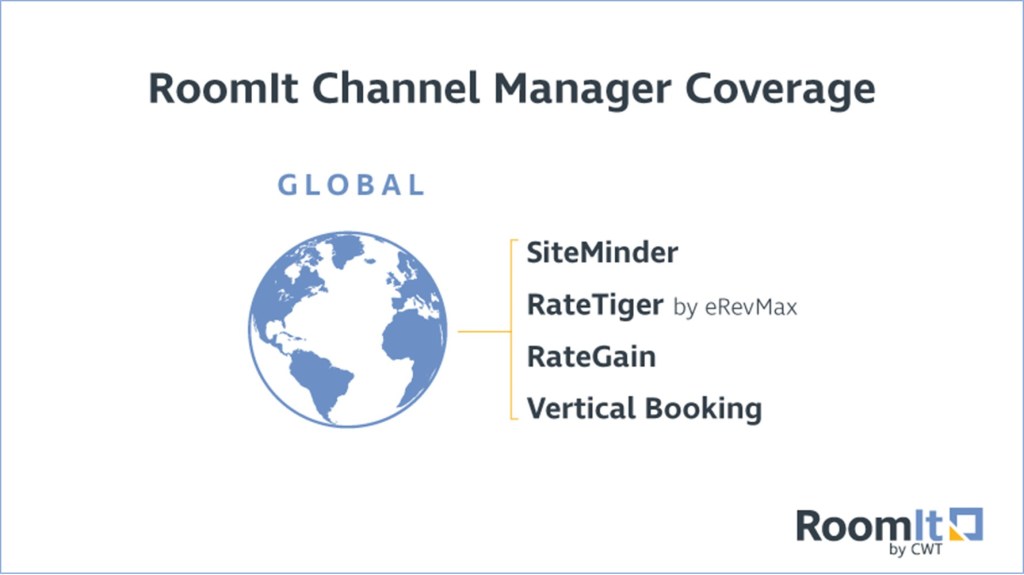
RoomIt by CWT expands hotel distribution with new, strategic global partnerships
“Hotels want to ensure their rooms are booked, and we want to guarantee our business travelers have the best access to rooms and rates near their destination,” said Shannon Hyland, Senior Vice President of Global Supply at RoomIt by CWT.In fact, many business travelers might be booking out of their company travel policy due to lack of availability of rooms that are both in policy and meet their needs. According to recent research by RoomIt & GBTA, business travelers say staying at a hotel close to where they need to be during their trip is just as important as having Wi-Fi access.
“By adding these partnerships, hotels not only have more distribution flexibility, but they’re able to amplify their visibility among business travelers, and we’re able to offer a better traveler experience,” said Hyland. “We are thrilled to engage in these partnerships with key local players, as they will allow us to provide superior local hotel content to our business travel customers in key markets such as India, Brazil and France.”
Properties connected via channel managers are available globally, for all points of sale through CWT travel counselors as phase one. To be eligible, participating properties must be located in a business travel destination and provide amenities and services that cater to business travelers, including last room availability, in-room Wi-Fi, same-day cancellations and loyalty points (if applicable).
Visit the RoomIt website for more information on RoomIt’s supplier offerings for individual hotels.
CWT is a leading global partner in business travel, meetings, and events. Operating across six continents, we deliver sustainable, tailored solutions that help organizations connect, engage, and thrive in an evolving world. Our myCWT platform integrates advanced technology with human expertise to simplify travel and enhance traveler and attendee experiences. Extensive global coverage, seamless data integration, AI-driven analytics, and carbon-conscious travel tools enable businesses to optimize their travel and meetings programs while delivering measurable value.
With 150 years of industry experience and a deep commitment to partnership, CWT collaborates with clients to shape the future of business travel and events, making them more efficient, responsible, and impactful.
RoomIt by CWT
RoomIt by CWT is the hotel distribution division of CWT. Every day we match travelers with the right room at the right rate, and every minute we book over 30 hotel rooms. We also provide travelers with the amenities and loyalty programs they want, while helping organizations control their budget and improve travel oversight. -

CWT research reveals positives significantly outweigh negatives at work and at home when traveling for business
Research by CWT, the B2B4E travel management platform, shows that business travelers feel that positives outweigh negatives at work (92%) and at home (82%) when traveling for business. Travelers from the Americas are the most enthusiastic at 94% and 86% respectively, followed by travelers from Asia Pacific at 93% and 84%, and Europe at 89% and 77%.
“Traveling to a new destination, meeting someone face-to-face for the first time, networking with people that can help you to advance your business as well as your career, and getting out of the work routine are some of the most exciting factors associated to business travel according to our findings” said Niklas Andréen, Executive VP and Chief Traveler Experience Officer at CWT. “It’s important that we recognize the true value that travelers find in their travels, and understand what provides the most positive benefits while on the road.”
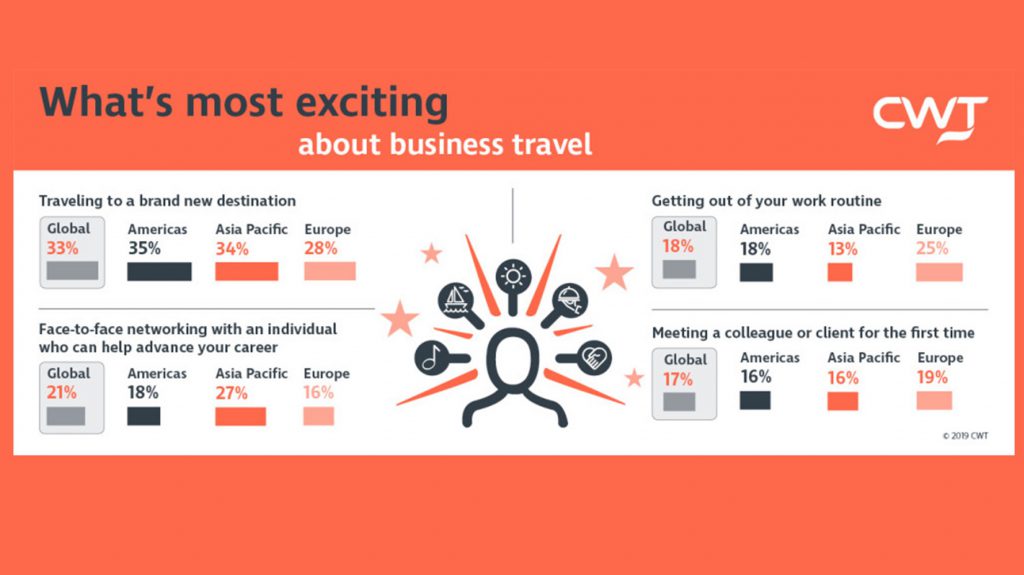
CWT’s research also shows that developing trust (39%), getting to know people better (32%), and efficiencies (31%) are the top three benefits of meeting with people in person for travelers worldwide.
European travelers value getting to know people the most (37%), followed by the Americas (36%), and travelers from Asia Pacific (25%). Europeans also value the efficiencies of meeting people face-to-face the most (34%), followed by travelers from Asia Pacific (31%), and the Americas (29%).
Bleisure Trends
Another perk of traveling for business is the possibility of extending a trip for pleasure. The average number of times in the past 12 months that the respondents have extended their trip is 2.4. Travelers from the Americas took the lead with 2.7 times, followed by 2.4 in Europe, and 2.3 in Asia Pacific. The average number of days – globally – was 4.3 days.
The research also uncovered that companies are mostly supportive of Bleisure travel if employees pay for their personal expenses (76%), especially in Asia Pacific (79%) and the Americas (77%). Companies in Europe fell short at 70%.
CWT is a leading global partner in business travel, meetings, and events. Operating across six continents, we deliver sustainable, tailored solutions that help organizations connect, engage, and thrive in an evolving world. Our myCWT platform integrates advanced technology with human expertise to simplify travel and enhance traveler and attendee experiences. Extensive global coverage, seamless data integration, AI-driven analytics, and carbon-conscious travel tools enable businesses to optimize their travel and meetings programs while delivering measurable value.
With 150 years of industry experience and a deep commitment to partnership, CWT collaborates with clients to shape the future of business travel and events, making them more efficient, responsible, and impactful.
-

Business trips – Tales from heaven and hell
According to our latest research, an overwhelming number of business travelers feel that the positives outweigh the negatives at work (92%) and at home (82%) when traveling for business.
I personally share this opinion. I adore traveling. Even though you might be enclosed in a room for the whole duration of your trip (it happens, you know it too), there is always a couple of hours you can steal to experience the vibe of the place you are in. It can be over dinner sampling local delis or during a walk in the morning to see how people go about their day. I am a big fan of people-watching. One of my favorite spots for it is the metro. Have you realized how different people are from home? The looks, the behaviors… It’s mesmerizing.
Sorry, I got distracted. Back to the survey… What is most exciting about business trips for the majority of travelers worldwide it’s traveling to a brand new destination. Face-to-face networking with an individual who can help to advance your career ranks second and getting out of your work routine third. Following closely behind is meeting a colleague or client with whom you have had only virtual contact for the first time and being able to expense things like meals and hotel rooms.
Travel disruptions lead the dark side of business trips, followed by personal safety, missing important family events or time with friends, having to catch up on work and home life upon your return, getting sick while traveling, recovering from the fatigue that comes with travel, coordinating logistics and packing, traveling to a place you have never been before, and meeting someone for the first time.
I share some of these joys and pains. However, my list is slightly different.
For me, what makes a particular business trip look like a gift from above is:
- Getting the chance to travel to a destination where I have friends (and a schedule that allows me to see them at some point). If I can extend my trip over a weekend for some quality time with them, the experience is unbeatable. Who does not like bleisure?
- Meeting my team. I am a remote worker and my teammates are spread all over the world. Any chance to meet them and share the joys and pains of a business trip is a blessing. When they are around, a good time is guaranteed.
- Discovering new destinations and cultures. Discovering new places, meeting interesting people, eating new things… Traveling is a mind-expanding experience. Plus, sometimes you get confronted with things you are not particularly comfortable with. It is a great muscle-building exercise for life. As someone I admired said to me once: “Get comfortable doing the things that make you uncomfortable.”
On the downside:
- Dealing with logistics. Visas, accommodation and flights… but first and foremost, packing.
- Facing Murphy’s Law scenarios. Getting sick, missing my flight, lost luggage, credit cards not being accepted, mobile phones not working during an emergency…You name it. If you are a worrier, I am sure you feel me.
- Schedules from hell. Waking up at 3 am to get to the airport, staying late for a business dinner after a long working day, getting home late and not having time to eat. Business trips can wear you down.
What about you? We would be most interested in knowing what makes you jump with joy or cry in pain when it comes to business travel.
Image credits: Adobe Stock
-
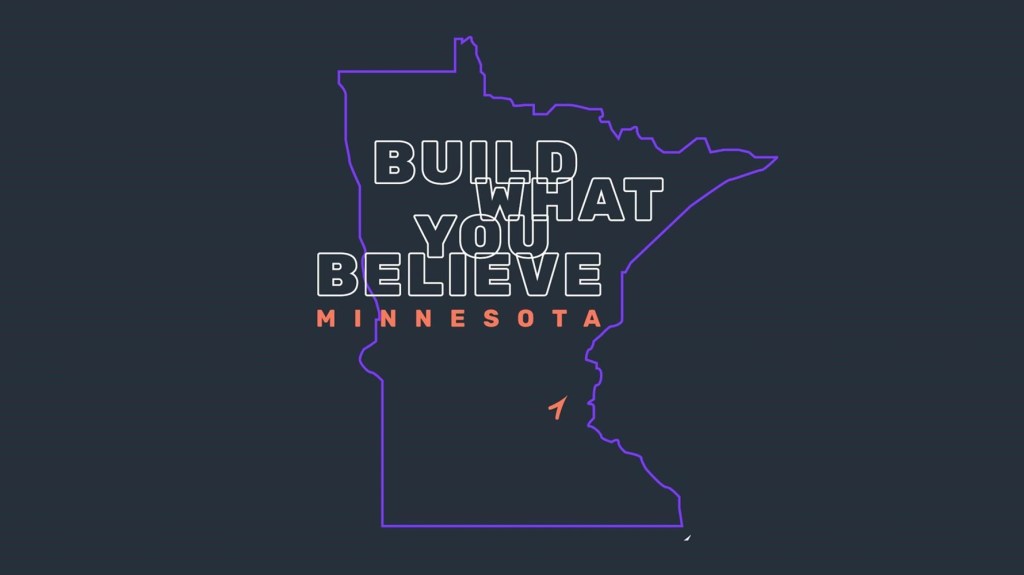
CWT and Carlson Family Foundation host Minnesota Hackathon to fight online child trafficking in partnership with Thorn
CWT, the B2B4E travel management platform, is hosting a hackathon on October 5-6 in Minneapolis involving dozens of local technologists working on technology tools to combat the sex trafficking and sexual abuse of children online.
The Build What You Believe hackathon is the first of its kind to be held in Minnesota and is the latest initiative that CWT and the Carlson Family Foundation are spearheading in their decades-long commitment to issues around human trafficking. This weekend’s hackathon is in partnership with Thorn, a non-profit organization founded in 2012 by Ashton Kutcher and Demi Moore, that is dedicated to building technology to defend children from sexual abuse. Their focus on the role of technology in these crimes allow them to build solutions that leverage the best technology to find child victims faster.
“We’re bringing technology to bear to solve this problem,” said John Pelant, CIO, CWT. “We have some of the city’s best engineers and data scientists coming together as a community of tech people and contributing their considerable professional skills so we can do our part to combat this illicit activity that has been exacerbated by the rise of the internet and different forms of social media.”
At least 50 data scientists and engineers from some of the largest companies in the Twin Cities, including Target and CWT, are participating in the hackathon. They will work in groups to try and solve technical problems using a variety of approaches including data analysis, natural language processing, computer vision, and machine learning. The teams will work to improve upon existing processes or validate new ideas. For example, participants can enhance existing optical character recognition tools to extract emojis that contain potentially important information about a trafficking situation. By rendering them searchable, law enforcement agents can more easily understand a victim’s trafficking situation and respond accordingly.
The Twin Cities hackathon is the latest in several similar hackathons Thorn has initiated from New York to San Francisco. Thorn operates the first in-house engineering and data science team focused solely on developing new technologies that can be deployed to help identify child victims faster, as well as against online sexual abuse and their perpetrators. Their technology tools are used by more than 8,000 law enforcement officers in 50 states and Canada to identify child trafficking victims that have been sold online. This includes at least 75 law enforcement agencies in Minnesota.
“At Thorn, we are working to bring the brightest minds to work on behalf of the most vulnerable children,” said Julie Cordua, CEO, Thorn. “When we build technology, we are working towards a world where every child can be safe, curious and happy. Working with CWT is allowing us to do exactly that. Tapping into brilliant minds in the Twin Cities, we are thankful for the volunteers committing their weekend to joining us at CWT’s headquarters to build what they believe.”
Since reaching out to Thorn in 2016, the Carlson Family Foundation has supported the organization whose mission is at the heart of the Foundation’s work. The Carlson Family Foundation’s involvement with protecting children against trafficking and all forms of exploitation dates back to the 1990s. It co-founded the World Childhood Foundation in 1999, a global organization that supports at-risk children around the world, including victims of sexual abuse. When Minnesota hosted the Super Bowl in 2018, Carlson, CWT’s parent company, served in a leadership role in the Super Bowl LII Anti-Trafficking Committee, that was funded, in part, by the Carlson Family Foundation. The committee went on to create a comprehensive and replicable plan to educate, prevent and disrupt such activities at large-scale events, while at the same time, providing services to survivors.
“For two decades, Carlson has been committed to combating human trafficking with every tool and resource possible,” said Diana Nelson, Carlson board member and a trustee of the Carlson Family Foundation. “The internet has created new challenges for this fight, and we are grateful for Thorn’s leadership to address those challenges—harnessing technology as a powerful force for good. We are inspired to see so many Minnesota technology professionals uniting with Thorn for the hackathon. This is truly life-saving work.”
CWT is a leading global partner in business travel, meetings, and events. Operating across six continents, we deliver sustainable, tailored solutions that help organizations connect, engage, and thrive in an evolving world. Our myCWT platform integrates advanced technology with human expertise to simplify travel and enhance traveler and attendee experiences. Extensive global coverage, seamless data integration, AI-driven analytics, and carbon-conscious travel tools enable businesses to optimize their travel and meetings programs while delivering measurable value.
With 150 years of industry experience and a deep commitment to partnership, CWT collaborates with clients to shape the future of business travel and events, making them more efficient, responsible, and impactful.
The Carlson Family Foundation
The Carlson Family Foundation is a Minnesota-based philanthropic foundation with a vision of uplifting youth through leadership at the intersection of love and insight. Established in 1959 by Curt and Arleen Carlson, the Foundation’s mission is to work together with the community to create opportunity, hope and a sense of belonging for every young person. Now involving three generations of the Carlson family, the Foundation partners with organizations that support young people through education and mentoring, and has worked closely with local, national and international partners to eradicate sex trafficking of young people.Thorn
Thorn, co-founded by Ashton Kutcher and Demi Moore, builds technology to defend children from sexual abuse. Thorn partners with nonprofits, law enforcement, and tech companies to understand the role technology plays in child sex trafficking, the creation and proliferation of child sexual abuse material, and the normalization of child sexual exploitation. Thorn then goes beyond insight to action to develop the tools, systems and approaches to help address these issues. Thorn’s software tool, Spotlight, is currently used by 10,000 law enforcement agents across all 50 US states. Thorn has also created a Technology Task Force — a group of more than 25 technology companies that collaborate on technology initiatives to fight child sexual exploitation. Participating companies include Amazon Web Services, Google, Facebook, Salesforce, Microsoft, Memsql, SV Angel, Twitter, Expedia, Digital Reasoning, Pinterest and others.For more information on Thorn, please visit http://www.thorn.org/. Follow us on Twitter @thorn and http://facebook.com/wearethorn.
-
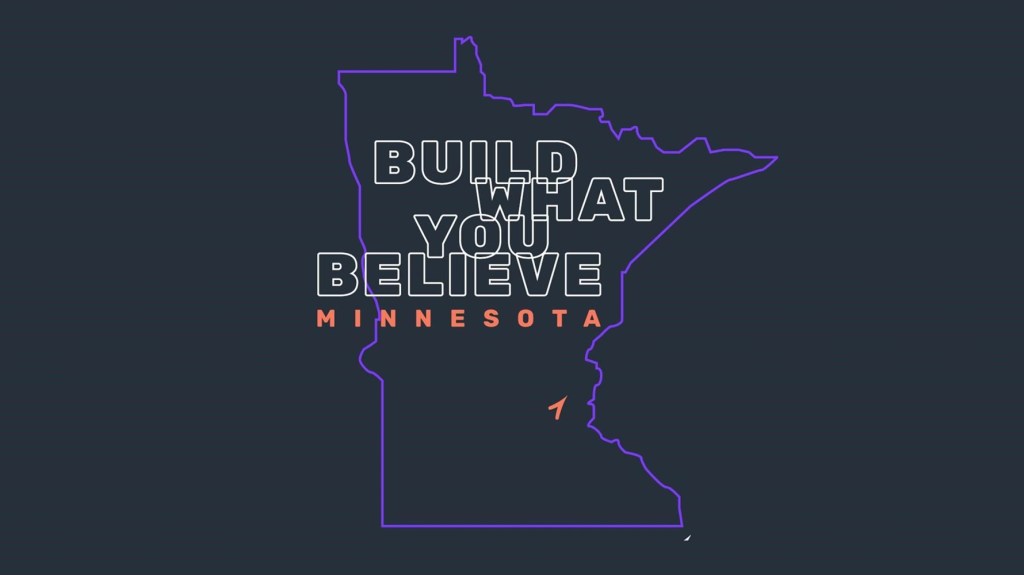
Minnesota technologists join forces to fight online child sex trafficking
A recent high-profile case involving the trafficking of minors for sex by a well-connected financier made headlines around the world. But for every victim uncovered by the media, there are thousands more spread out across the country — their numbers and markets multiplied by the sheer pervasiveness of technology.
The internet and social media are gaining an outsized role in how victims are found, bought and sold, with transactions involving the abuse of minors done no differently from how you and I shop for clothes and shoes online.
With the role of technology in perpetuating the abuse, it is abundantly clear that technology is also the means to stay ahead of traffickers. Minnesota companies will get a chance to play their part by bringing together some of the private sector’s top data scientists to work on ways to spot victims and abusers online and to rid the internet of child sexual content. It’s an initiative that’s led by CWT, a Minnesota-based global travel management company, that has long championed anti-human trafficking efforts, including the trafficking of minors.
In the Twin Cities alone, a six-month study by local prosecutors found over 34,000 advertisements posted online for sex, according to the Office of Minnesota Attorney General Keith Ellison. In at least 82% of juvenile trafficking cases in Hennepin and Ramsey Counties, from January 2012 to August 2016, sex buyers entered the market through backpage dot com and other online media, according to WATCH, a nonprofit monitor of the justice system in Minnesota, now part of the Advocates for Human Rights.
As the chief information officer at CWT, I come at this from four different perspectives. First and foremost, I am the father of two children whose safety and wellbeing I deeply safeguard and cherish.
Second, I work in the travel industry, where historically, trafficking has been commonly associated with transporting victims across borders and illicit activity occurring in hotels. As we now know, trafficking in the U.S. often happens domestically with no need to cross state lines, much less a national border, and the abuse can take place anywhere. Globally, 77% of victims are exploited within their country of residence, according to a 2019 Trafficking in Persons report by the State Department.
Third, Carlson, CWT’s parent company, has had a long history of fighting anti-trafficking, dating back to the 1990s. In 2004, we were the first travel and hospitality company to sign ECPAT’s Code of Conduct for the Protection of Children from Sexual Exploitation in Travel and Tourism (The Code) at the request of UNICEF and the U.S. State Department. When Minnesota hosted the Super Bowl in 2018, Carlson and the Carlson Family Foundation collaborated with local organizations and community leaders in creating a replicable plan to curtail sex trafficking at large-scale events. Carlson also co-founded the World Childhood Foundation, which supports at-risk children globally, including victims of sex trafficking.
Carlson and CWT have partnered with governments and organizations on all fronts in the fight against trafficking, which brings me to my fourth point — my belief in the role that technology must play and the contribution our own technologists can make—to end this scourge.
On the first weekend of October, a hackathon that aims to use technology against child sex trafficking will come to Minnesota, following similar events in New York and San Francisco. It will be led be a non-profit organization we’ve partnered with called Thorn, founded by Ashton Kutcher and Demi Moore, whose mission is to build and use technology to defend children from sexual abuse. Over 200 investigators and 75 law enforcement agencies in Minnesota use Thorn’s technology, and it is expanding throughout the Midwest.
The Minnesota hackathon will bring together 50 of the most talented technologists and engineers from the Twin Cities business community to chip away at this massive problem, one technology tool at a time. Technologists will spend the weekend volunteering their considerable professional skills to fighting abuse and trafficking using a variety of approaches, including data analysis, natural language processing, computer vision and machine learning that can help find victims faster and scrub the internet of child sexual abuse materials.
In so doing, we hope to raise awareness in our communities here in Minnesota that domestic minor sex trafficking is present in all 50 states. We need to be educated in the role that technology plays in child sexual exploitation and the many resources that are available online, and off, to curtail this illicit activity.
Whether it’s conducting trafficking training for employees, supporting a local organization working to provide services for survivors, or reporting suspicious online activity or possible child trafficking — this is an issue that deserves our attention – and action – long after the news cycle has passed.
This op-ed piece originally appeared in the Pioneer Press, a leading daily in Minnesota.
-

The fight for freedom: How organizations successfully combat human trafficking
Did you know, there are more modern-day slaves in our world than at any other point in history? And that human trafficking is believed to be the third-largest crime industry in the world, behind drugs and arms trafficking?
Statistics like these can feel tragic and utterly overwhelming. However, today there are more people working to end human trafficking and modern-day slavery than ever before. Globally there are many organizations dedicated to eliminating human-trafficking, and few of these are large or well-known. Instead, they work at grassroots, to unravel the tangle of criminal enterprises trading in human life. They hold governments and businesses accountable. They use their resources to take a stand and help to amplify the voices of survivors.
Each organization has a different strategy, but all of them, little by little, are making major strides in ending human trafficking. CWT is supportive of many organizations focused on this issue including those outlined below.
Eliminating child sexual abuse from the internet
Thorn is one of the leading groups in the United States developing technical tools and systems to eliminate sexual abuse and child trafficking from the internet. In 2014, the organization prototyped a product named ‘Spotlight’, which it gave away to law enforcers to help identify child sex trafficking victims who were sold online. As a result, Spotlight has helped to successfully identify 9,380 victimized kids since 2016.
Providing futures for trafficking survivors
Nomi is an organization creating economic opportunities for survivors and women at risk of human trafficking across Cambodia and India. Since 2007 the organization has coached 8,000 trafficking victims in leadership, entrepreneurship, and technical skills whilst creating safe-employment for 5,000.
Disrupting human trafficking networks globally
Named after the North Star that guided slaves to freedom in the U.S., Polaris was established in 2002 to help survivors restore their freedom, prevent more victims and pursue traffickers wherever they operate. Since 2007, its’ National Human Trafficking Resource Center hotline and BeFree Textline have learned of and responded to 31,000 instances of human trafficking across the United States.
Standing up against human trafficking takes courage, but anyone can get involved by supporting an anti-trafficking group or taking a stand on an individual level. In 2017, CWT launched its own dedicated global Anti-Human Trafficking taskforce which works with partners such as Thorn and Polaris to fight abuse, exploitation and trafficking. This coming weekend (October 5-6) CWT CIO, John Pelant will lead a CWT and Thorn hosted hackathon, bringing together the city’s top technologists to try and solve some of the child trafficking problems exacerbated by technology.
Image credits: Adobe Stock
-

Human trafficking – Putting an end to lives bought and sold
What images does the word “slavery” conjure up in your mind? People in iron collars shipped on huge wooden galleons, forced to work the fields under the whip of the master? Perhaps you think that slavery is a concept abolished in the 1800’s?
The sobering reality, however, is that behind closed doors, slavery continues to exist in our modern world. In fact, slavery not only exists but flourishes in the form of human trafficking for profit and exploitation, affecting the lives of millions of people around the world and robbing them of their dignity.
Traffickers deceive women, men, and children from all corners of the world and force them into exploitative situations every day. While the best-known form of human trafficking is for the purpose of sexual exploitation, hundreds of thousands of victims are trafficked for the purposes of forced labor, domestic servitude, child begging or the removal of their organs.
The truth about human trafficking is that it’s a very serious worldwide problem. These statistics show exactly what that look like.
- There are currently over 40 million people trapped in modern slavery – 25 million of which are stuck in forced labor.
- Every year forced laborers do work worth £150 billion – the types of labor include domestic, factory, farm, and construction work. Of that work, about $46.8 billion’s worth takes place in developed countries, which includes the U.S. and many European countries.
- 72% of victims are women and girls – traffickers are mainly targeting women and girls, with most victims detected across the world being adult women (49%), and increasingly girls (23%). The vast majority are trafficked for sexual exploitation, with 35% trafficked for forced labor.
- Human trafficking doesn’t always look forced at first – in most cases, victims are recruited into sexual slavery by intimate partners. Of the 7,859 victims of sex trafficking that America’s National Human Trafficking Hotline identified in 2018, 1078 of them were recruited through a proposition from an intimate partner — sometimes even a proposition of marriage.
Human trafficking is a heinous crime that CWT is committed to battling, by placing substantial efforts into developing more effective policies, research, and tools to embed it firmly into our Responsible Business strategy.
Through our collaboration with partners including World Childhood Foundation, ECPAT, Thorn, and The Orphaned Starfish Foundation, we continue to strive to do more. On October 5-6, in Minneapolis, CWT and Thorn will host a hackathon bringing together the city’s top technologists to try and solve some of the child trafficking problems exacerbated by technology.
Image credits: Adobe Stock
-
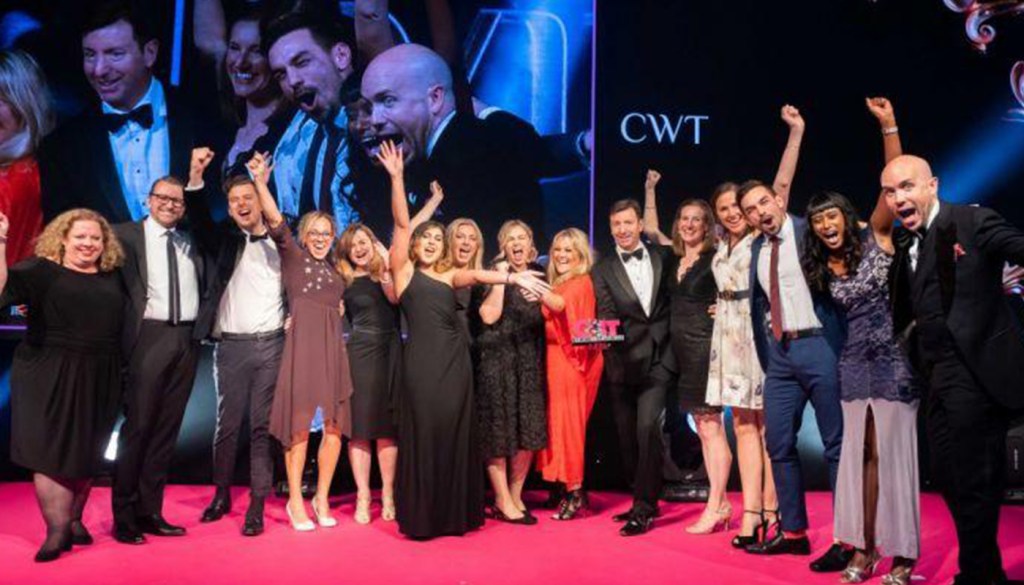
The main event – How to choose a meeting and events agency, by 2019’s Global Agency of the Year
There is no doubting the power of face-to-face in today’s tech-heavy, socially-connected world. And since Millennials ignited the experience economy, the growth of the events industry has accelerated faster than a viral meme.
Event platform Bizzabo found that 41 percent of marketers considered event marketing to be their top marketing channel—up 32 percent year-on-year ahead of content marketing and social media.
The upshot of a global boom in events is that the industry is becoming more crowded and competition stronger. So when – this September – CWT Meetings and Events won the top spot in the annual ranking of the top 50 UK event agencies by C&IT (Conference and Incentive Travel), followed by ‘Global Agency of the Year’ at the C&IT Industry Awards having increased our events turnover to £62m, we were truly humbled.
It takes a great deal to stay in the lead. But, not all prospective clients know what to look for in a meetings and events agency. Here’s what an agency worthy of such an accolade should offer you.
1. Playing to their strengths
Being a truly global agency isn’t just about presence but how to connect expertise around the world. A good events agency combines data from travel and events under one live dashboard. For travelers, a meeting or event is often their reason to travel. The traveler is an attendee. More than ever, clients are looking to consolidate business travel with meetings and events. The analysis of that data is critical to globalizing programs and driving success for companies that operate in more than one locale.
2. They don’t imitate, they innovate
A superior agency invests in creative people who know how to translate the ethos of your brand into live experiences. They’re at the forefront of innovation and ideas in technology, food content delivery and all-important CSR (corporate social responsibility) activities. From dating-style apps that help attendees break the ice to content that travels around the conference room via poolside meetings or hikes, the festivalisation of events continues its rise . Push your agency to identify the microtrends that they’ll be seeing a lot of and make sure of the highest returns on event.
3. Experience is king
Demand is growing for events that are experiential and multi-sensory in nature. The imminent rollout of 5G will make connections quicker and faster. Wow your clients with excellent service and their attendees with an experience that will last a lifetime. You’ll be rewarded with social shares and a lasting impact on attendees. This builds brand loyalty and employee engagement and commitment.
4. Be at the vanguard
Our research shows an 83% increase in the number of event apps created since 2017 and a rise in virtual reality, augmented reality and bots. Technology plays a major role in today’s events. Not only should an agency provide a seamless experience and answer the needs of the younger generations, they should capture data and analyze it to motivate attendees, drive actions and deliver exceptional results year over year.
More customers are looking to globalize their meetings & events programs with data sitting at the core. We have been rolling out a single, unified technology platform across all four major regions of the world to ensure our teams in each market are recording data in the same way – benefiting industry and customers. It’s important to innovate but always with a view to whether it’s possible to roll out solutions globally.
5. Remember CSR & have fun!
Most corporations have clear responsible business activities. Ensure that you work with an agency that can build your brand values into key activities throughout the event. We all know that organizing events can be stressful. Don’t let the pressure overwhelm you. Choose an agency with whom there’s a positive personal connection. It’s an old cliché but teamwork really does make the dream work.
-
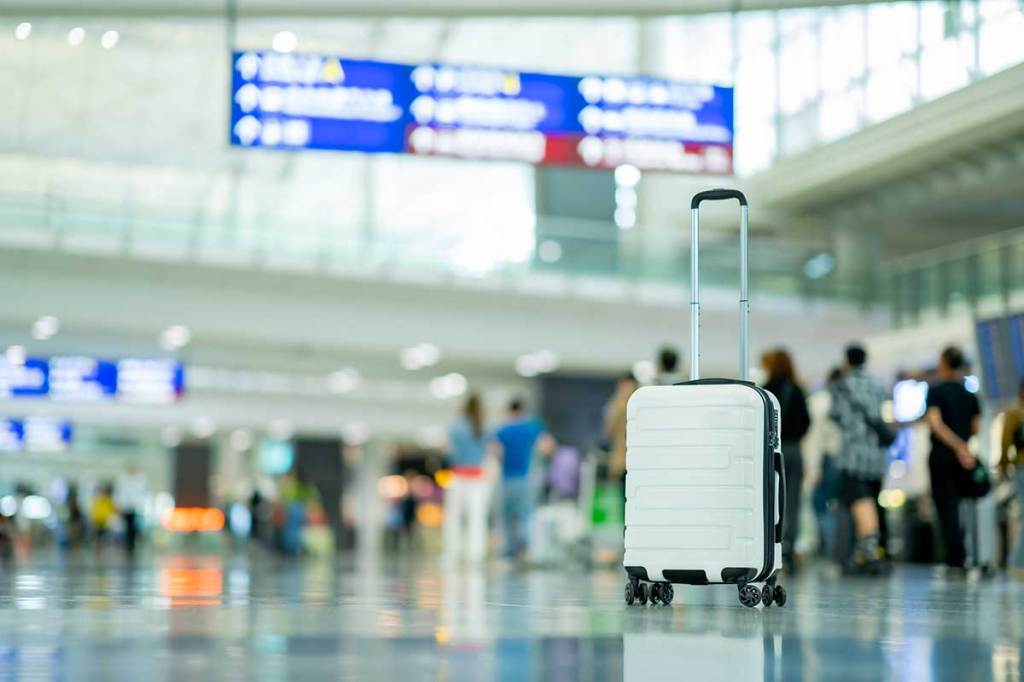
Where’s my suitcase? Will there be a transformation in luggage handling?
Not long ago, I came across an article by PhocusWire. The author questioned whether or not consumer demand for convenience will transform the baggage experience.
If you have been in the travel industry for a while, you have probably seen a raft of changes: The introduction of low-cost carriers, the sharing-economy, personalization, predictive analytics, the ancillary services model…The list is endless.
Will baggage be the next area for a revolution?
According to the article “airlines in the United States collected $4.6 billion in checked baggage fees in 2017.” This comes as no surprise taking into account that since the beginning of the economic downturn of 2008, airlines and other industry players started to become more creative with their pricing in order to secure their bottom line results.
A report by Idea Works showed that ancillary services increased from $32.5 billion US dollars in 2011 to $82.2 billion in 2017. Although this amount is not purely based on checked luggage, there is no doubt that it plays an important role.
Low-cost carriers opened the can and legacy actors followed by creating a more complex pricing structure designed to compete with the new players. Premium classes have not been affected, but the lowest economy fares have seen a service that was free not that long ago, now comes with a fee.
Nowadays, airlines are charging for checked baggage, but what are they doing to improve the experience? It seems not much has been done to enhance this service. In fact, in some cases, travelers need to label their own suitcases and place them onto belts: The so-called self-service kiosks.
The article also addressed lost luggage. This has not improved either, and the consequences of a suitcase not arriving on time can ruin important business trips.
I remember a client that was traveling to China to receive an award at a glittering gala ceremony. Her luggage got lost. Being a tall person, finding a replacement outfit for the event was not easy. Thankfully, she managed to find a tailor that was able to deliver an outfit in under 24 hours, but this was a real coup.
With all of this in mind, will delivery companies take over and look after luggage? In an era where Amazon can deliver anything to your door in 24 hours, it seems airlines might get new competition.
Image credits: Adobe Stock